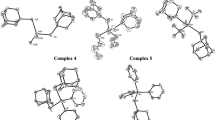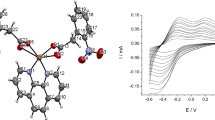Abstract
Eight novel macrocyclic complexes as candidates of antifungal agent were designed and synthesized by incorporating an N4 donor site via the template condensation of 4,4′-diaminodiphenylmethane, formaldehyde. p-anisidine, and metal salts. The structural features were determined on the basis of their elemental analyses, magnetic susceptibility, molar conductance, FAB Mass, UV-Vis, and IR spectral data. Electronic absorption spectral data of the complexes suggest a square-planar geometry around the central metal ion except the VO(IV) complex, which shows square-pyramidal geometry. The stoichiometry of the complexes had been found to be 1: 1 (metal: ligand). Electrolytic nature of the complexes is assessed from their high conductance data. Monomeric nature of the complexes is confirmed from magnetic susceptibility values. The X-band ESR spectra of the Cu(II) and VO(IV) complexes in DMSO at 300 and 77 K were recorded, and their salient features are reported. The antifungal activity of the macrocyclic metal complexes were screened in vitro against Aspergillus niger, Aspergillus fluvus, Trichoderma harizanum, Trichoderma viridae, and Rhizoctonia solani. The data showed that they possessed antifungal activity.
Similar content being viewed by others
References
Srinivasan, S., Athappan, P., and Rajagopal, G., Transition Met. Chem., 2001, vol. 26, p. 588.
Franco, E., Torres, E.L., Mendiola, M.A., and Sevilla, M.T., Polyhedron, 2000, vol. 19, p. 441.
Ashu, C., and Singh, R.V., Indian J. Chem., Sect. A: Inorg., Bio-inorg., Phys., Theor. Anal. Chem., 2001, vol. 40, p. 1330.
Chitra, G., Indian J. Chem., Sect. A: Inorg., Bio-inorg., Phys., Theor. Anal. Chem., 2002, vol. 41, p. 763.
Biyala, M.K., Fahmi, N., and Singh, R.V., Indian J. Chem., Sect. A: Inorg., Bio-inorg., Phys., Theor. Anal. Chem., 2004, vol. 43, p. 2536.
Singh, N.K., Singh, S.B., Singh, D.K., and Chauhan, V.B., Indian J. Chem., Sect. A: Inorg., Bio-inorg., Phys., Theor. Anal. Chem., 2003, vol. 42, p. 2767.
Venkatesvvar Rao, P. and Venkata Narasaiah, A., Indian J. Chem., Sect. A: Inorg., Bio-inorg., Phys., Theor. Anal. Chem., 2003. vol. 42. p. 1896.
Kong, D., Meng, L., Song, L., and Xie, Y., Transition Met. Chem., 1999, vol. 24, p. 553.
Al-Sha’alan, N.H. and Riyadh, P.O., Molecules, 2007, vol. 12, p. 1080.
Irobi, O.N., Moo-Young, M., and Anderson, W.A., Int. J. Pharm., 1996, vol. 34, p. 87.
Reiner, R., Antibiotics—An Introduction, Switzerland: Roche Scientific Services, 1992, vol. 1, p. 21.
Shakir, M., Kumar, D., and Varkey, S.P., Polyhedron, 1992, vol. 11, p. 2831.
Navaneetha, N., Nagarjun, P.A., and Satyanarayanan, S., J. Chem. Sci., 2007, vol. 119, p. 29.
Nakamoto, K., Infrared and Raman Spectra of Inorganic and Coordination Compounds, New York: Wiley, 1997.
Efthimiadou, E.K., Sanakis, Y., Katsaros, N., et al., Polyhedron, 2007, vol. 26, p. 1148.
Warad, D.U., Satish, C.D., Kulkarni, V.H., and Bajgur, C.S., Indian J. Chem., Sect. A: Inorg., Bio-inorg., Phys., Theor. Anal. Chem., 2000, vol. 39, p. 415.
Lever, A.B.P., Inorganic Electronic Spectroscopy, New York: Elsevier, 1968.
Mishra, L. and Singh, V.K., Indian J. Chem., Sect. A: Inorg., Bio-inorg., Phys., Theor. Anal. Chem., 1993, vol. 32, p. 446.
Sharma, P., Chand, M., and Nagar, M., Indian J. Chem., Sect. A: Inorg., Bio-inorg., Phys., Theor. Anal. Chem., 2003, vol. 42, p. 2778.
Sharma, A.L., Singh, I.O., Singh, M.A., and Singh, H.R., Transition Met. Chem., 2001, vol. 26, p. 532.
Ray, R.K. and Kauffman, G.R., Inorg. Chim. Acta, 1990, vol. 173, p. 207.
Yen, T.F., Electron Spin Resonance of Metal Complexes, New York: Plenum Press, 1969.
Anjaneyula, Y. and Rao, R.P., Inorg. Met.-Org. Chem., 1986, vol. 16, p. 257.
Srivastava, R.S., Inorg. Chim. Acta, 1981, vol. 56, p. L65.
Author information
Authors and Affiliations
Corresponding author
Additional information
The article is published in the original.
Rights and permissions
About this article
Cite this article
Raman, N. Antifungal active tetraaza macrocyclic transition metal complexes: Designing, template synthesis, and spectral characterization. Russ J Coord Chem 35, 234–238 (2009). https://doi.org/10.1134/S1070328409030129
Received:
Published:
Issue Date:
DOI: https://doi.org/10.1134/S1070328409030129




